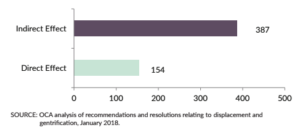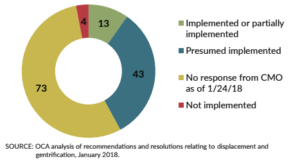Austin is full of anti-gentrification ideas, but most wouldn’t have a direct impact
Tuesday, February 6, 2018 by
Audrey McGlinchy, KUT Since 2000, the city of Austin has had a lot of ideas about how to slow down gentrification. A task force recommended in 2002, for example, that the city educate residents about available property tax exemptions. In 2008, City Council members asked the city manager to find city-owned land suitable for affordable housing.
And there were 539 other recommendations.
As part of a new report, the Office of the City Auditor put together a list of City Council and task force recommendations created with the hopes of mitigating gentrification. The list, which dates back to 2000, includes 541 recommendations or resolutions.
But the auditor’s office found only a quarter of these recommendations would directly affect gentrification, could be acted on or were not restricted by state law.

“There’s a whole lot of them that are kind of impractical as written or are too broad or vague,” said Katie Houston, an assistant city auditor. “Really, if we’re going to move forward with a lot of these recommendations, writing them in a manner that makes them more actionable would be really useful.”
Of the 133 recommendations that staff considered actionable, 56 have been implemented. Four have not been implemented, and the auditor’s office is still waiting to hear back on the status of the other 73.
 Between 2000 and 2010, Austin lost 5 percent of its black population, as many people felt pushed out of East Austin by rising housing costs.
Between 2000 and 2010, Austin lost 5 percent of its black population, as many people felt pushed out of East Austin by rising housing costs.
Council asked staff to compile the report in August, at the same time a new anti-displacement task force was formed. The hope was that the city, which has had at least three other task forces on gentrification since 2000, would not be duplicating past efforts.
“I want to honor their work and to let them know we recognize it, we value it and we’re not redoing that work – we’re rebuilding it,” said Mayor Pro Tem Kathie Tovo, who called for the latest report.
The report also notes that the statuses of many of the anti-gentrification suggestions aren’t being tracked.
Download (PDF, 5.57MB)
This story was produced as part of the Austin Monitor’s reporting partnership with KUT. Photo by Jorge Sanhueza-Lyon/KUT.
The Austin Monitor’s work is made possible by donations from the community. Though our reporting covers donors from time to time, we are careful to keep business and editorial efforts separate while maintaining transparency. A complete list of donors is available here, and our code of ethics is explained here.
You're a community leader
And we’re honored you look to us for serious, in-depth news. You know a strong community needs local and dedicated watchdog reporting. We’re here for you and that won’t change. Now will you take the powerful next step and support our nonprofit news organization?








